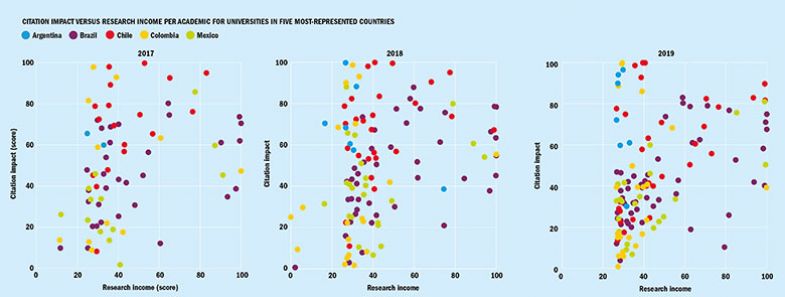Browse the full Times Higher Education Latin America University Rankings 2019 results
For all the history and culture that the nations of Central and South America may share, they can perform quite differently when it comes to higher education.
First, as the main map (below) shows, a clear east-west split in South America is apparent on internationalisation.
Each dot on the map represents a university in the Times Higher Education Latin America University Rankings coloured by its international outlook pillar score, which measures the share of an institution’s students and staff that come from abroad as well as cross-border research activity.
Top five collaborators in selected South American countries by share of co-authored publications in region
Brazilian universities tend to have much weaker scores in this pillar, which might reflect the country’s size but potentially also other factors such as language. Meanwhile, universities towards the west – in countries such as Chile, Peru and Ecuador – seem to score higher. The picture in Central America and the Caribbean is more mixed.
Because of its size and research capacity, Brazil dominates as the main collaboration partner for other countries in South America, as shown by the above bar charts on international research co-authorship. However, its importance to other nations varies: Brazil makes up almost 60 per cent of Argentina and Colombia’s internationally co-authored papers in the region but only about 35 per cent of Ecuador’s.
Citation impact versus research income per academic for universities in five most-represented countries
The bar charts also highlight the absence of some countries as major regional research collaborators, although it may be surprising that Venezuela, despite its political problems, is still the third-biggest partner for Ecuador.
The scatter plots (above) show how different countries’ universities fare for citation impact and research income per academic.
Over time, there has been a clear improvement among Argentina’s universities for citation impact, despite no obvious shift in research income scores. Chile stands out as a country where universities seem to be receiving relatively more research funding over time and are consistently doing well on citation impact. In Brazil and Mexico, however, institutional performance on both measures is more mixed.
Who has the most outward-looking campuses?
Register to continue
Why register?
- Registration is free and only takes a moment
- Once registered, you can read 3 articles a month
- Sign up for our newsletter
Subscribe
Or subscribe for unlimited access to:
- Unlimited access to news, views, insights & reviews
- Digital editions
- Digital access to THE’s university and college rankings analysis
Already registered or a current subscriber? Login









